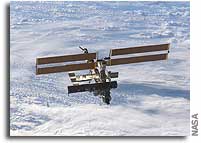ISS On-Orbit Status 2 Feb 2003

Mourning for the Columbia Seven, Rick, Willie, Mike, Dave, KC, Laurel and Ilan, our hearts go out to their loved ones while gratefully taking notice of expressions of grief and condolence from around the world. We also deplore deeply the loss of the incredible wealth of 80 scientific experiments accumulated on board the flight during the 16-day mission of STS-107 and the terrible impact of that loss on our science teams and more than 70 international scientists.
On the ISS, all systems continue to function nominally, except as noted previously or below. Ahead: Week 10 for Expedition 6.
At Baikonur this morning, Progress 10P (M-247) launched successfully on time (7:59am EST), and all deployments and downlinks were reportedly nominal. After a last-minute review yesterday of possible manifest changes, the cargo ship, with about two tons of equipment and supplies, is on its way to the ISS. Docking is scheduled for 2/4 (Tuesday), at 9:48am. [A recent Kurs system test showed that approach and docking can be performed with only one of the two radio guidance antennas at the Service Module (SM) solar array tips involved.]
For the crew, it was a quiet Sunday with a minimum of scheduled tasks.
FE-1 Nikolai Budarin worked briefly on the Russian laptop 3, returning it to its initial configuration after yesterday’s “Relaksatsiya” observation of the Progress 9P deorbit.
Budarin then completed the regular daily checkup of the BIO-5 Rasteniya-2/Lada-2 (“Plants-2”) plant growth experiment.
Afterwards, he performed the weekly routine tasks of collecting SP toilet flush counter and SVO water supply readings for calldown, as well as the periodic check-out of the Elektron oxygen generator’s VM gas/liquid system for the air bubble that usually lingers after an in-flight maintenance (IFM).
Nikolai also conducted the periodic routine inspection of the BRPK air/condensate water separator in the SM.
FE-2/SO Don Pettit completed the regular daily task of SOSh life support systems maintenance, and took care of the daily IMS database update file preparation.
Pettit again took two ppCO2 (carbon dioxide partial pressure) readings with the CDMK (CO2 monitoring kit) in the SM and Lab, one in the morning, one in the evening, to help resolve discrepancies between ppCO2 readings in the SM by the SM gas analyzer and in the USOS (U.S. segment) by the MCA (major constituents analyzer).
Budarin prepared for and performed another monthly session of the Russian MBI-9 “Pulse” experiment, task-listed and performed before the morning physical exercise. [Execution of the medical cardiological assessment is controlled from the Russian laptop 3, using a set respiration rate (without forced or deep breaths) and synchronizing respiration with computer-commanded “inhale” commands. Before the experiment, he was to measure his arterial blood pressure with the “Tensoplus” sphygmomanometer. The first “Pulse” session by Nikolai was performed on 11/30/02, the second on 12/30/02.]
Also working from the Russian task list, Budarin was again scheduled for the Uragan Earth observations program. [Yesterday’s Uragan targets for the Nikon D1 were Bouvet Island and South Georgia Island (for ice sheet dynamic analysis), Himalayas and Southern Patagonia icefield in “convergence shooting” (series of consecutive frames while keeping the target at the center of the camera’s field of view), and the city of Lagos. Today’s targets were Bouvet and South Georgia Islands, convergence photography of Southern Patagonia icefield, Galapagos Islands and the Panama Canal.]
For the task-listed Diatomeya ocean observations sessions, Budarin yesterday and today focused on selected seawater bloom features (bioproductive areas) in the waters of the South Atlantic and Indian Ocean.
All crewmembers had their weekly family conferences, Budarin via VHF, Bowersox and Pettit on S-band. For Sox and Don, the schedule also provided for the regular private psychological conferences.
The crew performed their daily physical exercise sessions on TVIS (treadmill), RED (resistive), and VELO cycle with load trainer.
Today’s targets for the CEO (crew earth observations) program were Ho Chi Minh City, Vietnam (ISS followed the delta coast of the Mekong River from SW to NE. Crew was to look left for Saigon on the easternmost delta distributary. Glint views of the delta waterways are possible from this track), SE Africa haze (winds are setting up to transport polluted air [industrial sulfates, smoke and dust from farmland] from the subcontinent over the recently identified “exit” on the SE coast of southern Africa. Only one photo exists of this phenomenon. Scientists are very interested to see what the exhaust plume looks like), Nile River Delta (nadir mapping strips requested. Salt poisoning of soils due to increased rates of irrigation [three crops per year versus the pre-Aswan rate of one crop per year] reduces usable farmland in the delta. Egypt loses as much cropland to salt as it gains by opening up new areas in the desert. Landuse changes are therefore constant in the delta), Panama (unusually clear weather persists. Detailed and regional views of this hard-to-photograph region are requested. Looking right of track for the canal zone), and Navassa Island corals, Caribbean (coral reef mapping project. Looking right for this island that lies between Haiti and Jamaica).
CEO images can be viewed at the website http://eol.jsc.nasa.gov
ISS Orbit (as of this morning, 7:22am EST [= epoch]):
- Mean altitude — 387.1 km
- Apogee — 390.7 km
- Perigee — 383.5 km
- Period — 92.30 min.
- Inclination (to Equator) — 51.64 deg
- Eccentricity — 0.0005385
- Orbits per 24-hr. day — 15.60
- Mean altitude loss in last 24 hours — 250 m
- Revolutions since FGB/Zarya launch (Nov. ’98) — 23999
- For more on ISS orbit and worldwide naked-eye visibility dates/times, see
- http://www.hq.nasa.gov/osf/station/viewing/issvis.html








